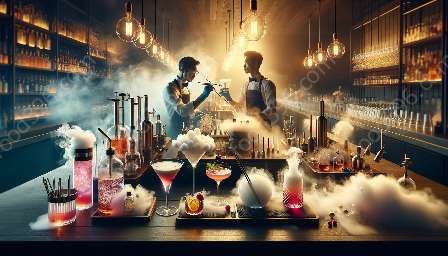Do you want to learn about the science behind molecular gastronomy, combined with the use of foaming agents to create exciting and innovative culinary experiences? Let's dive into the mesmerizing world of molecular gastronomy and explore how it intersects with foam and spherification techniques, as well as molecular mixology.
Molecular Gastronomy: Exploring the Science of Food
Molecular gastronomy is a culinary discipline that takes a scientific approach to cooking and explores the physical and chemical transformations that occur during the preparation and consumption of food. It involves the study of the physical and chemical processes that occur while cooking, as well as the mechanisms behind the sensory perceptions of food.
This approach has allowed chefs to push the boundaries of traditional cooking by experimenting with textures, flavors, and presentations, ultimately resulting in creatively innovative dishes and dining experiences.
Foaming Agents: Unleashing Culinary Creativity
Foaming agents, an essential element in the realm of molecular gastronomy, play a pivotal role in the creation of airy and luscious foams that enhance the texture and flavor of various dishes. These agents enable chefs to introduce air into liquids, transforming them into stable and captivating foams.
By utilizing foaming agents, chefs can elevate the dining experience by incorporating captivating textures and flavors into their culinary creations. This innovative use of foaming agents adds a fascinating dimension to the gastronomic landscape, allowing for the reinvention of traditional dishes and the development of entirely new culinary delights.
Foam and Spherification Techniques: Culinary Alchemy
Foam and spherification techniques are integral components of the molecular gastronomy toolkit that enable chefs to craft extraordinary culinary marvels.
These techniques involve the manipulation of food textures and forms, allowing for the creation of ethereal foams and enticing spheres that captivate both the eyes and the palate. By mastering these techniques, chefs can orchestrate a symphony of flavors and textures, offering diners an unforgettable sensory experience.
Molecular Mixology: Infusing Science into Beverages
Molecular mixology, a concept closely aligned with molecular gastronomy, applies scientific principles to the art of cocktail making. By integrating foaming agents and spherification techniques into mixology, bartenders can unlock an entirely new realm of innovative and visually stunning drink creations.
Through molecular mixology, mixologists can push the boundaries of traditional cocktail crafting by incorporating intriguing textures, flavors, and visual elements. This convergence of science and artistry results in beverages that dazzle the senses and elevate the overall drinking experience.
The Intersection of Science and Culinary Creativity
The fusion of molecular gastronomy, foaming agents, foam and spherification techniques, and molecular mixology represents a revolutionary approach to culinary and beverage creation. By harnessing scientific knowledge and culinary artistry, chefs and mixologists can embark on a journey of endless innovation, surprising and delighting diners and imbibers alike.
Embracing these modern gastronomic and mixological techniques allows for the elevation of dining and drinking experiences, inviting individuals to explore new frontiers of flavor, texture, and presentation in the culinary world.
Conclusion
By delving into the captivating realm of molecular gastronomy, foaming agents, foam and spherification techniques, and molecular mixology, we unravel the intricate interplay between science and art within the culinary and beverage spheres. This convergence presents an exciting opportunity for culinary and mixological exploration, paving the way for boundary-pushing creativity and innovative sensory experiences.
Whether you are a culinary enthusiast, a professional chef, or a mixology aficionado, embracing these disciplines offers a gateway to unparalleled creativity and culinary alchemy. As the boundaries between science and gastronomy continue to blur, the landscape of culinary and mixological possibilities expands, offering a feast for the senses and an inexhaustible source of inspiration.

